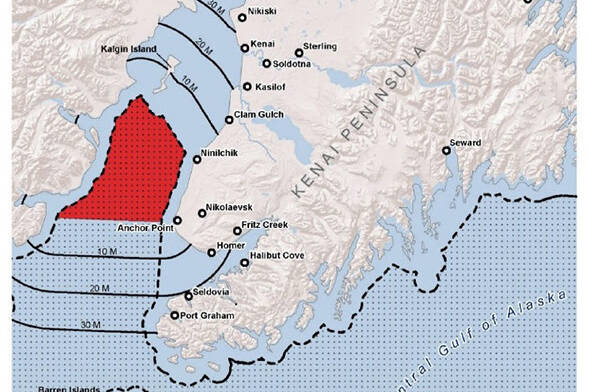Federal management of the Cook Inlet exclusive economic zone will begin on May 30, after the National Oceanic and Atmospheric Administration Fisheries published on Monday their long developing regulation.
Commercial drift gillnet fishers in the zone, which is a space of Cook Inlet waters from south of Kalgin Island to about Anchor Point, will have new regulations and requirements under the new rule. According to a release from NOAA Fisheries, they will need a federal permit, maintain a fishing logbook and have a vessel monitoring system installed, among other regulations.
The fishery will also use “total allowable catch” limits for management, as opposed to fishing based on escapement goals like state fisheries. If those counts are hit for any salmon, the fishery will be closed. Proposed counts for each species of salmon are described in an April publication, though final numbers are expected to be published in June.
In the proposed numbers, the total allowable catch for Kenai River late-run sockeye salmon is 492,100. Kasilof River sockeye salmon are also included in the chart, as well as “aggregate other” but neither have limits described.
For king salmon, the low abundance of which have seen several other sport and commercial fisheries entirely closed, the total allowable catch is set at 240 in the proposed regulation.
For coho salmon, the limit is 25,000; chum salmon is 99,400; pink salmon is 121,700.
The commercial fishing season in the zone will begin June 20 and close “on or before” Aug. 15, with closures coming earlier if total allowable catch for any salmon species is reached before the end of the season.
Sport fishing will be allowed in the zone, with no federal permits, but fishers will need to comply with federal regulations and state regulations — including bag limits.
The rule comes after years of back and forth that began in 2012, according to previous Clarion reporting, when the zone was removed from the federal Fishery Management Plan. In 2016, a Court of Appeals ruling required the North Pacific Fishery Management Council reintroduce the zone into their plan by 2020, but when that group elected to close the commercial fishery in the area for the 2022 season, the United Cook Inlet Drift Association sued to keep the waters open.
Per a decision by an Alaska District Court in June 2022, NOAA was directed to implement an amendment to the Salmon Fisheries Management Plan by May of this year.
When proposed regulations were published in October, the State Department of Fish and Game said it had “significant concerns” with the details of the rule. They said that the proposed management conflicts with state objectives to conserve and manage weak stocks, specifically by using a total allowable catch metric rather than allowing opportunity above escapement goals like in state managed fisheries.
Informational meetings will be held in Kenai and Homer this month to familiarize fishers with the new regulations. In Kenai, a meeting will be held at the Quality Inn on May 15, from 5:30 p.m. to 7:30 p.m. In Homer, a meeting will be held at the Best Western Bidarka Inn on May 16, also from 5:30 p.m. to 7:30 p.m.
An online webinar will also be held on May 22, from 10 a.m. to 12 p.m.
For more information, including to view the whole text of the rule or join the webinar, visit fisheries.noaa.gov.
Reach reporter Jake Dye at jacob.dye@peninsulaclarion.com.


